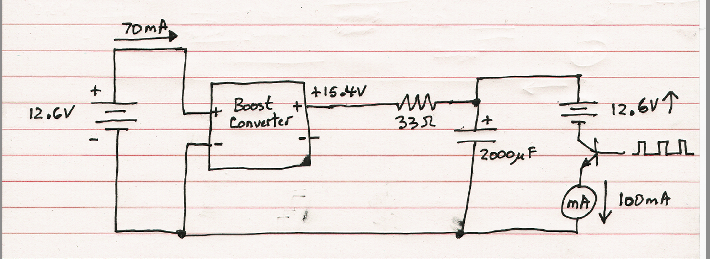Hi Matt,
Yes I seem to get the most efficient charging with these batteries if I charge the cap to about 14.75 volts and dump it more slowly than I was. I am also charging with a longer dump time. I am now using a 15 millisecond dump and 60 millisecond recharge time. Over all current seems to be the same but the battery is taking it better.
I think what I am mostly doing right now is just reconditioning the charge battery. Once I get that done then I can see if this circuit will be able to charge batteries and sustain itself too.
I was able to get the resistance down to 10 ohms by turning the boost circuit down quite a bit. But that also seems to have improved my run to charge current ratio. I am still not able to find a combination that will let me do away with the resistor totally. I did try adding more resistance but that did not improve things any.
I am trying to take it slow and easy on reconditioning this battery. I am almost out of batteries to play with. Time to take the shorted ones back to the salvage yard and trade them for some more to play with. I really think this circuit might be the best one I have found for reconditioning the batteries even if it does not prove to be self sustaining.
Thanks for the tips.
Later,
Carroll
Yes I seem to get the most efficient charging with these batteries if I charge the cap to about 14.75 volts and dump it more slowly than I was. I am also charging with a longer dump time. I am now using a 15 millisecond dump and 60 millisecond recharge time. Over all current seems to be the same but the battery is taking it better.
I think what I am mostly doing right now is just reconditioning the charge battery. Once I get that done then I can see if this circuit will be able to charge batteries and sustain itself too.
I was able to get the resistance down to 10 ohms by turning the boost circuit down quite a bit. But that also seems to have improved my run to charge current ratio. I am still not able to find a combination that will let me do away with the resistor totally. I did try adding more resistance but that did not improve things any.
I am trying to take it slow and easy on reconditioning this battery. I am almost out of batteries to play with. Time to take the shorted ones back to the salvage yard and trade them for some more to play with. I really think this circuit might be the best one I have found for reconditioning the batteries even if it does not prove to be self sustaining.
Thanks for the tips.
Later,
Carroll
 Because this setup is dealing with sending a charge current to a battery, which is not a 'normal' type of load, it is hard to say if this really could be COP > 1 even if you confirm that output charge current is higher than the input current to the boost converter. Batteries are electro-chemical devices and analyzing what is going on with them, especially when using pulsing, is a whole different kettle of fish to normal resistive loads, as I am sure you know well. It is all still really interesting however.
Because this setup is dealing with sending a charge current to a battery, which is not a 'normal' type of load, it is hard to say if this really could be COP > 1 even if you confirm that output charge current is higher than the input current to the boost converter. Batteries are electro-chemical devices and analyzing what is going on with them, especially when using pulsing, is a whole different kettle of fish to normal resistive loads, as I am sure you know well. It is all still really interesting however. 

 Still can't explain it.
Still can't explain it. 
 I am using the lawn and garden tractor size batteries. I think they are called U1. I can get them for $5 a piece at the salvage yard and if they don't recondition I take them back and turn them in for the lead salvage price. So it cost me very little to have a good selection of batteries to play with.
I am using the lawn and garden tractor size batteries. I think they are called U1. I can get them for $5 a piece at the salvage yard and if they don't recondition I take them back and turn them in for the lead salvage price. So it cost me very little to have a good selection of batteries to play with.
Comment